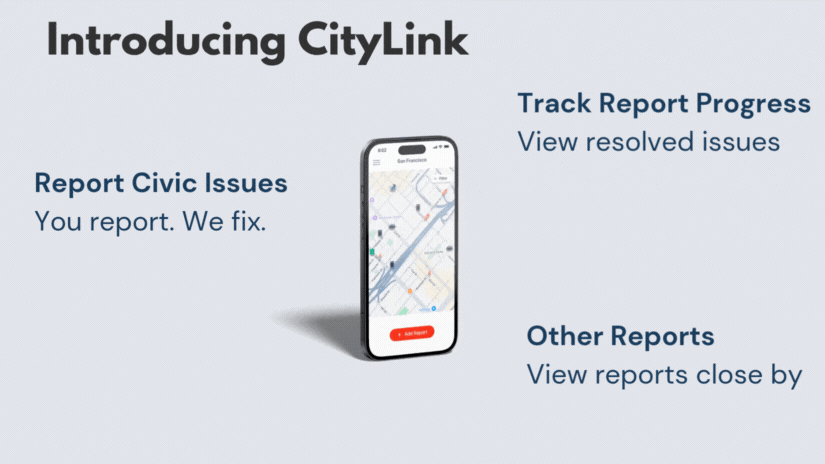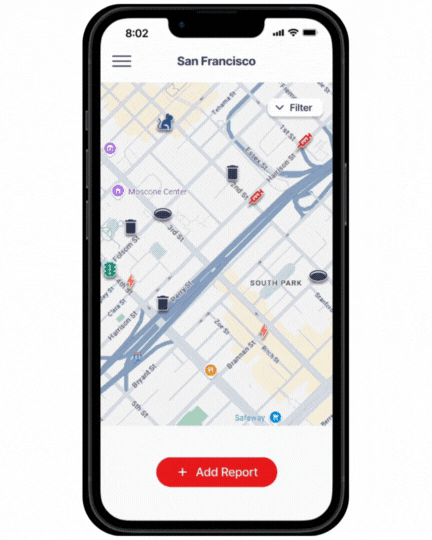.png)
Role
Solo UX Designer
1 Designer
24 Hours
Responsibilities
Product Design
Product Management
Strategic Thinking
UX Research
Protothon is an annual 24‑hour hackathon that invites students and early-stage creators to ideate, prototype, and pitch solutions to real-world challenges. Participants choose from multiple tracks, such as the “City Track,” which focuses on improving civic infrastructure and urban services. Within each track, teams (or individuals) conduct rapid research and design before presenting to mentors and judges.
For the City Track at Protothon 2025, the challenge centered on improving how citizens interact with city infrastructure and report issues. My research focused on understanding the pain points in current city service reporting systems, such as the lack of feedback after submission, confusing user interfaces, mobile incompatibility, and no status tracking on requests. I reviewed existing platforms like 311 apps and municipal portals, finding they often featured cluttered layouts, unclear next steps, and minimal transparency. Users frequently shared frustration over feeling ignored or left in the dark. Armed with these insights, I prioritized a clean, intuitive user flow, clear progress indicators, and feedback loops, making sure users felt heard, informed, and empowered throughout the process.

Our goals focused on building a safer and cleaner community within cities. We wanted to make sure that a community was built between resident to resident; resident to city officials.
Users will:
→ Have a cleaner city
→ Feel safer
→ Build community
→ Have a way of talking to city officials
Measured By:
→ Reports by residents
→ Reduced civil issues
→ Amount of reported and fixed issues
CityLink will:
→ Build connections with residents
→ Streamline the process of reporting city issues
→ Track community reports
→ Provide adequate feedback, transparency, and updates
Measured By:
→ New users onboarded in app
→ DAU/MAU/YAU
→ Customer satisfaction by reviews
Erica is a San Francisco resident who wants to navigate her city safely, quickly, and cleanly. She often has to adjust her schedule around broken streetlights, car accidents, and potholes that delay her commute to work. Erica just wants a way to easily report civil issues she encounters and more importantly, to track the progress of her own reports as well as those submitted by other San Francisco residents.
.png)
Ensure Erica can navigate San Francisco quickly while feeling safer and cleaner
.png)
%20(1).png)
As part of Protothon, participants had the option to have their projects reviewed by a mentor before submission. I knew I wanted my user flow to feel seamless, intuitive, and accessible, so I took full advantage of this opportunity. During the review, I learned that the background image on my “Add Report” page was too visually distracting, pulling attention away from the actual content. I was also made aware of a few accessibility concerns—specifically, that my bright red primary color didn’t meet contrast standards, and the frosted glass header made the title text hard to read.These insights were a turning point. For my final designs, I replaced the red with a darker shade that passed WCAG AA standards and removed the distracting background and frosted glass effects. This experience helped reinforce how essential it is to prioritize clarity and accessibility in every design decision.
.png)
.png)
.gif)
.gif)

CityLink is a tool designed to help residents report and track city issues in a way that feels simple, clear, and empowering. When users open the app, they're greeted with step-by-step instructions on how everything works. They can log in to personalize their experience and keep track of their activity over time.
Reporting an issue is straightforward. Users can add a title, description, photos or videos, and select a category like parking, roads, or streetlights. They can pin the exact location on a map or type in a street address with additional details. To reduce clutter, CityLink shows similar existing reports, so users don’t accidentally submit duplicates.
Beyond reporting, users can explore a community feed of public reports, where they can upvote issues they care about and leave comments to share input or offer more context. CityLink also features a dashboard where users can view the status of their submissions, whether they’re in review, in progress, or completed. There's even a Saved Reports section for quick access to updates on issues they’re following.
In short, CityLink empowers users like Erica to take action, stay informed, and make their city better. Together.

While I didn't win any award at Protothon 2025, the experience of pushing myself to design an entire project solo in just 24 hours against over 170+ participants was incredibly rewarding. I made new connections, learned from mentors and fellow participants, and built a design that judges described as visually clean and thoughtfully structured. They appreciated the strong user flow and how it tackled key challenges using appropriate design components. Highlights included several well-executed design details in the mock-ups. Their feedback also pointed out areas for improvement, for example maintaining visual consistency, enhancing onboarding screens with richer visual elements, and rethinking the home screen to act more like a dashboard. They also suggested adding features like progress indicators, map-based filtering, and potential AI integration. Overall, I had an amazing experience and I'm proud to say judges stated that "most of the problems are addressed perfectly".
One of the biggest takeaways from Protothon 2025 was learning how to push myself and build an end-to-end product under extremely tight constraints. Working solo with just 24 hours forced me to focus, make fast decisions, and stay resourceful. I also learned the importance of prioritizing accessibility and functionality over purely visual design. I initially thought the color palette, background image, and frosted glass effects looked great, but I hadn’t considered how inaccessible they might be for some users. This was a crucial realization that changed how I approach design. Attending this hackathon also showed me the real value of showing up. I had the chance to receive incredible mentorship from professionals at top companies like Microsoft; an opportunity I know not every student gets. It reminded me that hackathons aren’t just about competing; they’re about learning, growing, and connecting with people who inspire you to be better.